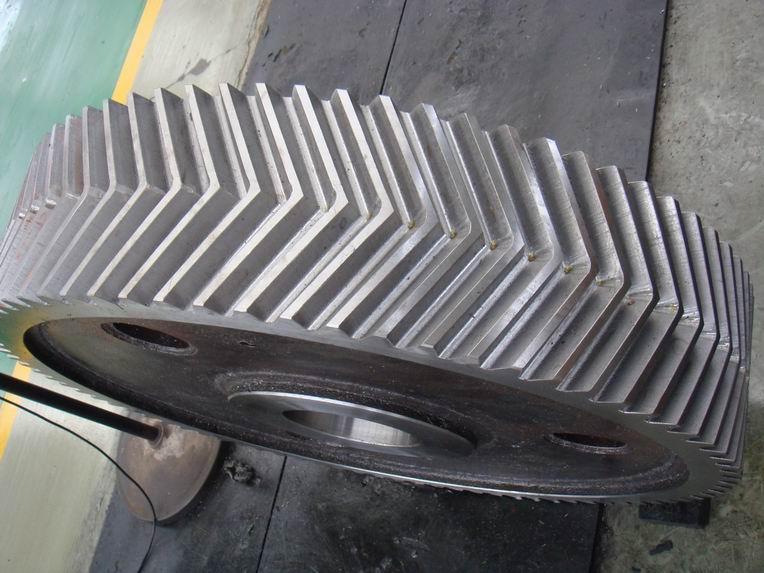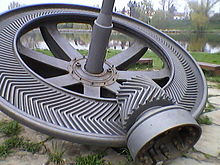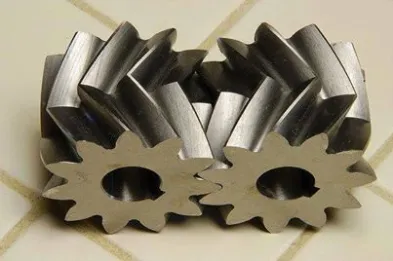Product Description
Metric Hobbing Carbon Alloy Steel Precision Gearbox Reducer Herringbone CNC Machining Auto Spare Parts Metal Transmission Drive OEM Grinded Miter Helical Gear
Features
1. High precision gear for smooth, quiet operation.
2. Flexible for custom-made requests.
3. Stable transmission, low impact, vibration and noise.
4. Heavy Load capability, more compact, but less complex.
Product Description
| Products | Spur Gear, Helical Gear, Herringbone Gear, Spiral Bevel Gear, Straight Bevel Gear, Worm Gear, Shaft, Pinion |
| Module | M0.3-M10 |
| Precision grade | DIN6, DIN7, DIN8, DIN10 |
| Pressure angle | 14.5 degree, 15 degree, 20 degree |
| Material | Medium Carbon Steel: 35#, 45# Carburizing Steel: 20CrMnTi, 20CrMnMo, 20CrMo Alloy Steel: 40Cr, 35CrMo, 42CrMo, 40CrNiMo Cast Iron: HT250, QT400 Copper, Stainless Steel, Brass, Nylon, POM, and so on |
| Heat treatment | Hardening & Tempering, Surface Quenching, Integral Quenching, Carburizing Quenching, Tempering, Normalizing, Nitriding |
| Surface treatment | Blacking, Polishing, Anodization, Chrome Plating, Zinc Plating, Nickel Plating |
| Application | Gearbox and reducer; Precision cutting machines, Lathes machines; Milling machines; Grinder machine; Automated mechanical systems; Automated warehousing systems. Gear hobbing machines, gear shapers, gear shaving machines, gear milling, gear grinding machines and many kinds of gear-related machines. |
| Machining process | Forging, Machining, Hobbing, Milling, Shaving, Grinding, Heat treatment… |
Detailed Photos
Our Advantages
Related Product
Company Profile
FAQ
Q: How to ship the planetary gear to us?
A: It is available by air, sea, or train.
Q: How to pay the money?
A: T/T and L/C are preferred, with different currencies, including USD, EUR, RMB, etc.
Q: How can I know if the product is suitable for me?
A: >1ST confirm drawing and specification >2nd test sample >3rd start mass production.
Q: Can I come to your company to visit?
A: Yes, you are welcome to visit us at any time.
/* March 10, 2571 17:59:20 */!function(){function s(e,r){var a,o={};try{e&&e.split(“,”).forEach(function(e,t){e&&(a=e.match(/(.*?):(.*)$/))&&1
| Application: | Machinery, Helical Gearbox |
|---|---|
| Hardness: | Hardened Tooth Surface |
| Gear Position: | External Gear |
| Samples: |
US$ 50/Piece
1 Piece(Min.Order) | Order Sample helical gear
|
|---|
| Customization: |
Available
| Customized Request |
|---|
.shipping-cost-tm .tm-status-off{background: none;padding:0;color: #1470cc}
|
Shipping Cost:
Estimated freight per unit. |
about shipping cost and estimated delivery time. |
|---|
| Payment Method: |
|
|---|---|
|
Initial Payment Full Payment |
| Currency: | US$ |
|---|
| Return&refunds: | You can apply for a refund up to 30 days after receipt of the products. |
|---|

What is the purpose of using herringbone gears in machinery?
Using herringbone gears in machinery serves various purposes and offers several advantages. Here’s a detailed explanation of the purposes and benefits of using herringbone gears:
- Smooth and Quiet Operation: Herringbone gears are known for their ability to provide smooth and quiet operation. The double helical tooth design cancels out axial and radial forces, minimizing gear vibrations and reducing noise levels during engagement. This makes herringbone gears suitable for applications where noise reduction and smooth operation are essential, such as precision machinery, automotive transmissions, and gearboxes in industrial equipment.
- High Load Capacity: Herringbone gears have a high load-carrying capacity due to their double helical tooth profile. The opposing helix angles of the gear teeth distribute the load evenly, allowing for efficient power transmission even under heavy loads. This makes herringbone gears suitable for applications that involve high torque requirements and heavy-duty machinery, such as mining equipment, construction machinery, and marine propulsion systems.
- Bidirectional Power Transmission: Herringbone gears can transmit power in both directions without the need for additional thrust bearings or special mechanisms. The double helical tooth profile cancels out axial thrust forces, eliminating the net axial thrust on the gear shaft. This bidirectional power transmission capability makes herringbone gears suitable for applications where reversible power transfer is required, such as marine propulsion systems, locomotives, and machine tools.
- High-Speed Applications: Herringbone gears are well-suited for high-speed applications due to their enhanced tooth strength and efficient torque transfer. The double helical tooth design provides increased tooth contact area and improved load distribution, allowing for reliable power transmission at high rotational speeds. This makes herringbone gears suitable for applications such as turbo machinery, power generation equipment, and high-speed gearboxes.
- Reduced Wear and Improved Durability: The double helical tooth profile of herringbone gears helps to minimize wear and improve gear durability. The opposing helix angles distribute the load evenly across the gear teeth, reducing localized stress concentrations and minimizing the risk of tooth failure. This ensures long service life and reliable operation, making herringbone gears suitable for applications where durability and longevity are critical, such as heavy machinery, industrial equipment, and wind turbine systems.
- Efficient Power Transmission: Herringbone gears offer efficient power transmission due to their large contact area and overlapping tooth engagement. The double helical tooth profile provides a larger contact ratio compared to spur gears, allowing for a greater number of teeth in contact at any given time. This efficient torque transfer minimizes power losses and improves overall gear system efficiency, making herringbone gears suitable for applications where energy efficiency is a priority, such as automotive transmissions, gearboxes, and power transmission systems.
The purpose of using herringbone gears in machinery is to achieve smooth and quiet operation, handle high loads, enable bidirectional power transmission, accommodate high-speed applications, ensure durability and longevity, and achieve efficient power transmission. These advantages make herringbone gears a preferred choice in various industries and applications where reliable and high-performance gearing solutions are required.

How do you maintain and service a herringbone gear system?
Maintaining and servicing a herringbone gear system is crucial for ensuring its optimal performance, longevity, and reliability. Regular maintenance and service activities help identify and address potential issues, minimize wear, and extend the lifespan of the gear system. Here’s a detailed explanation of how to maintain and service a herringbone gear system:
- Inspection: Conduct regular visual inspections of the gear system to identify any signs of wear, damage, or misalignment. Inspect the gear teeth, shafts, bearings, and other components for any visible abnormalities, such as pitting, scoring, cracks, or excessive wear. Check for oil leaks, loose fasteners, or any other potential issues that may affect the gear system’s performance.
- Lubrication: Ensure that the lubrication of the herringbone gear system is adequate and meets the manufacturer’s recommendations. Monitor the lubricant level and condition regularly. Check for proper lubricant distribution and coverage on the gear teeth and contact surfaces. Replenish or replace the lubricant as necessary to maintain the required film thickness and lubricating properties.
- Alignment and Clearance: Check and maintain proper shaft alignment to prevent misalignment-related issues. Use alignment tools such as dial indicators or laser alignment systems to verify the parallelism and concentricity of the gear system shafts. Ensure that the gear engagement is correct and that there is appropriate gear backlash. Make any necessary adjustments to optimize gear alignment and clearance as per the manufacturer’s guidelines.
- Fasteners and Connections: Regularly inspect and tighten all fasteners, such as bolts, set screws, or clamps, to ensure that they are securely fastened. Loose fasteners can lead to misalignment, vibration, and potential gear system failure. Follow the recommended torque specifications provided by the manufacturer when tightening the fasteners to avoid over-tightening or under-tightening.
- Monitoring and Analysis: Implement a monitoring and analysis program to track the performance of the herringbone gear system over time. This can include vibration analysis, temperature monitoring, and oil analysis. These techniques can help identify any abnormal conditions, such as excessive vibration, increased temperatures, or the presence of contaminants or wear particles in the lubricant. Regular analysis and monitoring can aid in detecting potential issues early and taking appropriate corrective actions.
- Repair and Replacement: If any signs of wear, damage, or abnormal conditions are detected during inspections or monitoring, take prompt action to address the issues. Depending on the severity of the problem, this may involve repairing or replacing worn or damaged components, such as gear teeth, bearings, or seals. Follow the manufacturer’s guidelines and consult with qualified technicians or professionals for any necessary repair or replacement procedures.
- Documentation and Record-keeping: Maintain accurate documentation and records of all maintenance and service activities performed on the herringbone gear system. This includes inspection reports, lubrication records, repair or replacement history, and any other relevant information. These records can serve as a reference for future maintenance, help track the gear system’s performance, and aid in troubleshooting or warranty claims if needed.
It is important to note that the specific maintenance and service requirements may vary depending on the gear system design, application, and operating conditions. Always refer to the manufacturer’s guidelines, technical documentation, and any applicable industry standards for the recommended maintenance practices and service intervals specific to your herringbone gear system.

Can you explain the unique shape of herringbone gear teeth?
The unique shape of herringbone gear teeth is a defining characteristic of herringbone gears, also known as double helical gears. Here’s a detailed explanation of the unique shape of herringbone gear teeth:
Herringbone gears have a V-shaped or herringbone-shaped tooth profile, which is formed by two helical gear sections that are mirror images of each other. This tooth profile is distinct from the straight or helical tooth profiles found in other types of gears such as spur gears or helical gears.
When viewed from the end, the teeth of a herringbone gear resemble the letter “V”. This shape is created by the combination of two opposing helix angles, one on each side of the gear. The helix angle refers to the angle at which the teeth are inclined relative to the gear’s axis.
In a herringbone gear, the helix angle of one helical section is opposite in direction to the helix angle of the other helical section. This means that as the gear rotates, the teeth on one side lean in one direction, while the teeth on the other side lean in the opposite direction.
The opposing helix angles of the two gear sections in herringbone gears serve several important purposes:
- Axial Thrust Elimination: One of the main advantages of the herringbone gear design is the elimination of axial thrust or end thrust forces. In helical gears, the helix angle of the teeth generates an axial force along the gear’s axis during rotation. However, in herringbone gears, the opposing helix angles cancel out these axial forces, resulting in a balanced gear that does not experience significant axial movement or require thrust bearings.
- Smooth Engagement: The opposing helix angles of herringbone gears facilitate smooth and gradual tooth engagement. As the gear rotates, the teeth on one side gradually come into contact with the teeth on the other side. This gradual meshing reduces sliding friction, minimizes backlash, and ensures a continuous and smooth transfer of power between the gear sections.
- Increased Load Capacity: The V-shaped tooth profile of herringbone gears provides increased tooth contact area compared to gears with straight or helical teeth. This increased contact area improves load distribution and allows herringbone gears to handle higher torque loads, resulting in an increased load-carrying capacity.
The unique shape of herringbone gear teeth requires precise manufacturing techniques to ensure proper meshing and alignment of the gear sections. The teeth must be accurately machined to achieve the correct helix angles and tooth profiles, ensuring smooth operation and efficient power transmission.
In summary, the unique shape of herringbone gear teeth, with their V-shaped or herringbone-shaped profile formed by opposing helix angles, enables axial thrust elimination, smooth engagement, and increased load capacity. These characteristics make herringbone gears well-suited for applications where efficient torque transmission, balanced operation, and high load-carrying capacity are essential.


editor by CX 2024-02-18